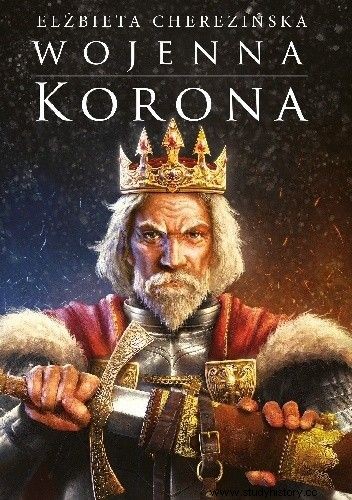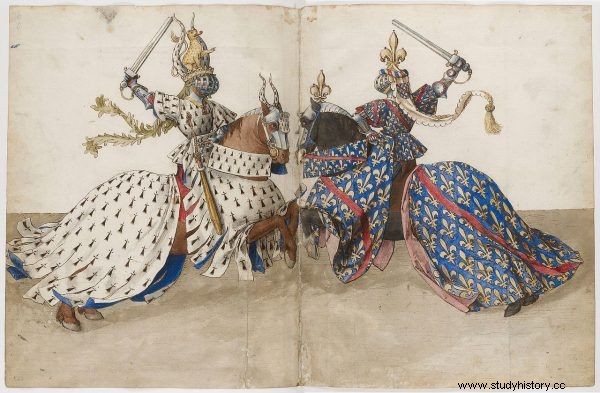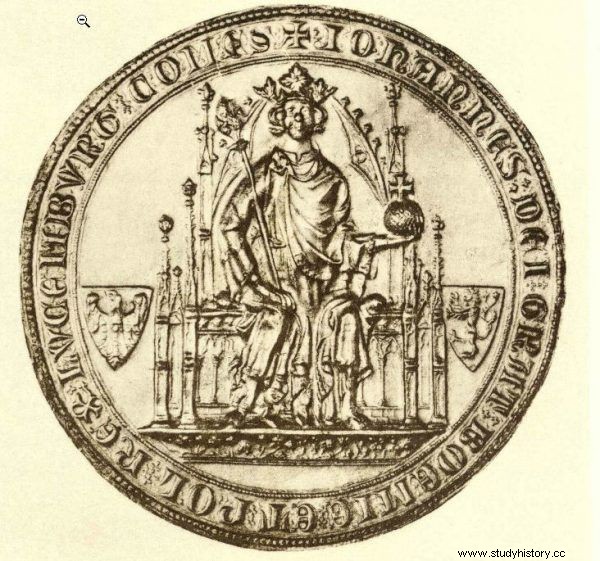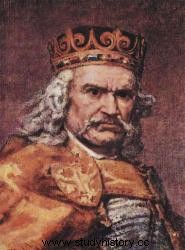He spent most of his life in the saddle. He was an excellent rider, a fan of knightly tournaments and a brilliant politician. Although he was German, he received the Czech crown from his father, which was sealed by his marriage to Eliška Przemyślidówna. John of Luxembourg soon demanded the Polish crown as well.
It was a sleepy winter morning in Prague. People were going to work and Jan took a momentary break from practicing and looked at the market that was prepared for the tournament. The window was wide open. The most beautiful man she had ever seen was standing there. He was naked and was staring right at her. He raised a bright, muscular arm, pointed with his finger in the direction, and nodded at her. Instinctively she looked where he showed .
The calm reigning in the square did not herald any upcoming events. In such circumstances of nature we meet the Czech King John of Luxembourg in the newest book by Elżbieta Cherezińska entitled "The Crown of War" .

Jan Luksemburski is one of the heroes of the newest book by Elżbieta Cherezińska "The War Crown"
Flawed Tournament
John of Luxembourg was famous for his love of knightly tournaments. Such tournaments were a phenomenon typical of the medieval era. They were not only the embodiment of knightly culture, but also had their practical application - they caused a constant improvement in the combat efficiency of knights .
The King of Bohemia first encountered the form of a knightly tournament in 1310 during his wedding with Eliška Przemyślidówna. After taking over the crown, the new king struggled for a long time with the country's internal problems and the aristocratic opposition. Therefore, he decided to accept the suggestion of a group of wealthy young men and in 1319 organize a great knightly tournament near Prague. Many distinguished foreign guests were invited, a fortune was spent on preparations, and a special wooden structure was erected adapted to such entertainment. The long-awaited day has finally come. Nobody came from foreign nobility. The chroniclers mention this event as completely nonsensical and too costly .

Knightly tournaments were a phenomenon characteristic of the Middle Ages
This evident defeat, however, did not stop the young king from organizing another tournament. As we read in Chronicle of Zbrasław already in 1321, many "noble lords" were invited to Prague again. It is before this tournament that John of Luxembourg stands in the window of his chamber, staring at the snow market, when we meet him in the "Crown of War" .
The king personally participated in the tournament, but it turned out that it did not end well for him. Elżbieta Cherezińska described these events in an extremely poignant way:
He groaned. What could have been a salvation was a trap. He saw the stands for the guests of honor crashing down. Floating banners with a Luxembourg lion and a flaming eagle. Breaking tournament pennants. Tumult, lamentation. People who tried to flee in all directions at once, trampled one another. At the same moment he felt his stallion stumble; he saw that he had stepped on the old man lying on the ground. He pulled on the reins with all his might, lest the horse crush his skull. A beam of sparks shot at them, the mount got scared, jerked, jumped and threw Jan from the saddle. He managed to curl up in flight, fell softly on the trampled, almost hot snow mud. He felt a pain in his chest, he wanted to get up quickly, but at that moment someone else's stallion stepped on him. Jan howled in pain, looked up. He did not recognize the knight.
The chronicle quoted earlier mentions that the king lay there in the mud for a long time before he was found and the nearly half-dead man was removed. His injuries were so strong that John of Luxembourg called his wife to him, despite the fact that the spouses had been very much at odds for a long time. It seems that the injuries were forgotten, as a result of which the royal son, Jan Henryk, was born at the beginning of the following year.
One might think that such an experience would break the Luxembourger and cause him to avoid horses and knightly tournaments. Nothing could be more wrong! Although Jan never organized a tournament in the Czech Republic again, he still participated in many such events in Western Europe during his life .
On the road it looks like he's not riding a horse, but rather flying
This is how he describes the abilities and love of John of Luxemburg's travels Chronicle of Zbrasław . We read further that if you had met him like this, you would sooner mistake him for a servant than for a lord . These descriptions are not surprising. The king spent most of his life in the saddle. This was also confirmed by examinations of his remains carried out in the 19th century, during which doctors found changes in the position of the pelvis and spine characteristic of riders. .
John of Luxembourg was a supporter of kings and emperors, an ally of the powerful of the world at that time, and a military commander. He led conquest expeditions as well as punitive expeditions for actual and alleged wrongs. He cared for the people of his country through expeditions against robbers and adventurers. In order to pursue such a policy, the king had to spend a lot of time in the saddle and move from place to place. And he had to do it quickly.
During the 36 years of his reign, he traveled 646 times in 224 different places. At least that much has been recorded. During his travels, he issued documents, 75% of which were created in Prague.

During his travels, John of Luxembourg issued many documents related to European politics
In order to meet his goals, the king moved across Europe extremely quickly. So fast that messengers sent after him with information often failed to catch up with him. Aragonese diplomat Ramón de Melan followed John across Europe to present him with a project of a crusade against the dissenters in Granada. He couldn't meet him anywhere until he found him in Paris. You might think that a diplomat would be admitted right away with a matter of such importance, but Ramón had to wait for the audience. The king was sleeping off his night ride and was gathering strength for the next trip.
It is estimated that an able rider could cover 60–70 kilometers a day in those days. The examples of John of Luxembourg's journeys prove that he was not only an efficient, but even extraordinary rider . According to calculations made on the basis of his travels, it is estimated that he could travel at least 80 kilometers in one day, and even 100 kilometers under the right conditions.
Give me Poland back
As Elżbieta Cherezińska remarkably accurately stated during the premiere of her latest book "The war crown" 29/10/2019 - the coronation of Władysław the Short as King of Poland in 1320 , in a sense, enrages the neighboring rulers. It causes that the ambitions of John of Luxembourg and his claims to the Polish crown, although our historians always say unfounded ... it is not true. In the light of the law of that time, he had something to fight for. He could have used various legal tricks of the time to prove that he was entitled to the Polish crown by way of inheritance .
John of Luxembourg's attitude towards Poland was the result of broad European politics and the Polish issue, however important, was not the most important one here. Both countries were in the opposition camps of the politics of the time - Poland supported the pope, the Czech Republic - the emperor.
After the coronation of Łokietek as king, as many as three people claimed the Polish throne - Władysław Łokietek, Jan Luksemburski and Henryk Karyncki, who still did not accept the fact that he had lost power in the Czech Republic.

After the coronation of Władysław Łokietek, three people claimed the right to the Polish crown.
John of Luxembourg claimed his right by way of inheritance. His marriage to Eliška Przemyślidówna - daughter of Wacław II provided him, in his opinion, sufficient justification for claiming rights to Polish lands. Moreover, there are legal acts that confirm the legitimacy of these claims .
Even during the reign of Wenceslaus II in Bohemia, the dukes of Bytom, Opole, Racibórz and Cieszyn paid him a feudal homage in the years 1289-1292. In this way, they gave themselves over to the authority of him and his successors. And although in Poland the right to the throne was not inherited by the female line, undoubtedly John of Luxemburg became the heir of these tributes through his marriage.
Add to this the fact that in 1291 prince Przemysł II also handed over to Wenceslaus II and his successors the rights to the Duchy of Kraków and Sandomierz. In 1299, Łokietek himself, after the defeat in Greater Poland, issued an act supporting John's claims later. Under it, the lands including Greater Poland, Pomerania, the lands of Łęczyca and Sieradz, and the Kujawy Brzeg were subordinated to the king of Bohemia.
"Luxembourg Eye" looks at Poland
Jan Luksemburski's interest in Poland can be divided into several phases, which depended on his current European policy. We will focus here on the first three, as they are important for the background of the "War Crown".
At the beginning of the reign of John Luxemburg in the Czech Republic, contacts with Poland seem to be relatively neutral, predominantly for good. This tendency in contacts with the Silesian Piasts was caused by the marriage of the daughter of Wacław II Małgorzata with Bolesław III, called by some Roz disposable, by others Hojny.
It is believed that the first interference in Polish affairs took place in the years 1311-1312 during the rebellion of mayor Albert in Krakow. It was a revolt of the German bourgeoisie against Władysław Łokietkowo and its task was to restore Czech rule in this area. However, there was no military intervention, and only one mention confirms the thesis that John supported the rebellion. Jan Luksemburski was supposed to pay back one of the townspeople of Kraków, Paweł of Brzeg, a loan taken out by Wenceslas II.
In 1312, the king also signed a treaty in Vienna with the Austrian princes Frederick and Leopold. Under it, they undertook, within the next 4 years, to support Jan in actions against the Krakow rulers, should the need arise.
Another treaty guaranteeing similar assistance was signed in 1314 in Cologne. Under it, the Wittelsbachs undertook to provide military aid to the King of Bohemia, should he decide to recover the lands that he deserved from Wenceslaus II.
In the following years, Jan Luksemburski's interest in Poland became much smaller. This was due to his policy, the center of gravity of which was shifted to other parts of Europe.
The eye of the king turned to our country again in the late 20's of the 14th century. In 1325 Władysław Łokietek faced the threat of war with the Teutonic Knights and entered into an alliance with Lithuania . A year later, both armies, on the initiative of Pope John XXII, set off in arms to Brandenburg. The purpose of this expedition was to weaken the position of Louis - Margrave of Brandenburg.
In response to these actions, the entourage of the German king Ludwig of Bavaria announced a Polish-Lithuanian expedition for the slaughter of the Christian Bavarian population. Polish forces have been accused of supporting pagans, and the Pope sending pagan hosts to murder innocent Christians has been hailed as the Antichrist .

"War Crown" is the fourth volume of the series "The Reborn Kingdom" by Elżbieta Cherezińska.
John of Luxembourg considered these events an ideal excuse for an armed attack. In January 1327, he called a general congress of the Czech nobility, where an extraordinary tax was levied in order to prepare the army. The king made one more neat political move and, on the basis of the rights he claimed to Polish territories, recognized the campaign as taking place within the country. Thanks to this, he saved a lot of money, as he avoided the additional fees for the knights that he would have to pay if the war were fought outside the Czech Republic .
In 1327 the army of John of Luxembourg entered Polish territory.
What could these events look like? What else happened in Polish-Czech relations in the years 1320-1327? How did Władysław Łokietek deal with all this? You will find the answer to these and many other questions in the newest book by Elżbieta Cherezińska, "The War Crown".
Sources:
- E. Cherezińska, War crown , Poznań 2019
- W. Iwanczyk, John of Luxembourg. The history of a turbulent life and the heroic death of the King of Bohemia and Count Luxemburg in 21 scenes , Warsaw 2012.
- The premiere of the book "Warrior's crown" by Elżbieta Cherezińska, Bookbook Bookstore (29.10.2019) Blogpressportal
